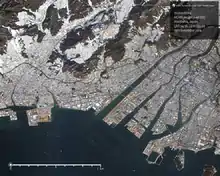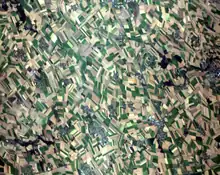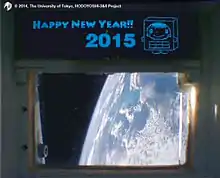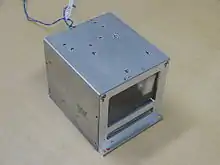| Mission type | Earth observation |
|---|---|
| Operator | NESTRA |
| COSPAR ID | 2014-033B |
| SATCAT no. | 40011 |
| Mission duration | 9 years, 6 months, 28 days (ongoing) |
| Spacecraft properties | |
| Manufacturer | University of Tokyo |
| Launch mass | 66 kg (146 lb) |
| Start of mission | |
| Launch date | 19:11, June 19, 2014 (UTC) |
| Rocket | Dnepr |
| Launch site | Dombarovsky |
| Orbital parameters | |
| Reference system | Geocentric |
| Eccentricity | 0 |
| Perigee altitude | 620 km (390 mi) |
| Apogee altitude | 620 km (390 mi) |
| Inclination | 97.9° |
Hodoyoshi-4 is a Japanese micro-satellite launched in 2014. The satellite is built in 0.5x0.6x0.7m box-shape bus, optimized for piggy-back launch. All instruments are powered by solar cells mounted on the spacecraft body and two stub wings, with estimated electrical power of 50W.[1] For orbit-keeping, a "miniature" (5 kg dry weight) ion thruster with specific impulse 1100s and operating power 20W is integrated into the body.[2] The satellite was developed under the Funding Program for World-Leading Innovation R&D on Science and Technology.[3]
Launch
Hodoyoshi-4 was launched from Dombarovsky (air base) site 13, Russia, on 19 June 2014 by a Dnepr rocket. Two-side communication with Earth was successfully achieved at 2nd pass over ground station.
Mission
The satellite is intended primarily for technology verification in space, main test piece being Earth observation telescope with nominal 6.7m GSD at 650 km altitude.




| Item | Value |
|---|---|
| GSD | 5-7m @ 600-650 km |
| Type | Pushbroom scan |
| Diameter | 150mm |
| Focal Length | 1,000mm |
| Swath | 24 km |
| Format | Raw, 12bit |
| Band | Blue: 0.45 um-0.52 um, Green: 0.52 um-0.60 um, Red: 0.63 um-0.69 um, NIR: 0.73 um-0.90 um |
Secondary mission is measurements of water level in rivers to monitor floods by using Store&Forward System.[5] Third mission is Hosted Payload. Hosted Payload mission consisted of 10 cm-cubic boxes on which users could install their own apparatuses for their own applications. Project members asked users in private partnership in order to explore new market of satellite utilization. One of the apparatuses was space message display system. Electronic message display was installed which operators could change characters on the display by sending commands from the ground station. Users can take photos of their messages with the view of the earth from the window.
See also
References
- ↑ "Archived copy" (PDF). Archived from the original (PDF) on 2016-10-11. Retrieved 2014-06-24.
{{cite web}}: CS1 maint: archived copy as title (link) - ↑ Koizumi, Hiroyuki; Komurasaki, Kimya; Arakawa, Yoshihiro (2012). "Development of the Miniature Ion Propulsion System for 50 kg Small Spacecraft". 48th AIAA/ASME/SAE/ASEE Joint Propulsion Conference & Exhibit. doi:10.2514/6.2012-3949. ISBN 978-1-60086-935-8.
- ↑ "Funding Program for World-Leading Innovative R&D on Science and Technology(FIRST Program) | Japan Society for the Promotion of Science". Archived from the original on 2016-03-04. Retrieved 2014-11-25.
- ↑ "Hodoyoshi 4".
- ↑ "Satellites to track Fukushima, Chernobyl effects". Business Standard India. 2014-06-19.
External links
- Hodoyoshi 4 on Facebook
- Nano-Satellite Center, University of Tokyo
- Hodoyoshi and UNIFORM satellites tracking